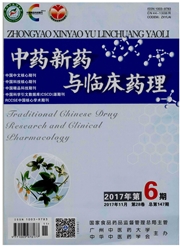

 中文摘要:
中文摘要:
目的 探讨龟板提取物(Plastrum Testudinis extracts,PTE)对大鼠触须部皮肤创面修复中Wnt/β-catenin通路的调控。方法 分离培养SD乳鼠毛囊干细胞(Hair follicle stem cells,HFSCs),免疫荧光检测细胞表面标志物CD34、CD71表达,CCK-8法检测PTE对HFSCs增殖的影响,Western-blot检测PTE对HFSCs中Gsk-3β、β-catenin蛋白表达的作用;制作SD大鼠触须部皮肤缺损模型,随机分为空白对照组、实验对照组、阳性药物对照组、PTE组,测算动物创面面积和愈合率,病理学及免疫荧光检测创面组织。结果 培养的细胞形态饱满,折光性强,呈铺路石样,细胞表面CD34及CD71阳性。CCK-8显示PTE对HFSCs有促增殖作用(P〈0.01)。PTE作用于HFSCs后,Gsk-3β蛋白(P〈0.05)下降的同时β-catenin蛋白表达上升(P〈0.001)。术后7 d各组创面基本愈合,PTE组及阳性药物对照组表皮较其他组薄,毛囊周围有新生表皮参与修复,表皮与真皮结合牢固,真皮无炎性细胞,组织结构排列规则,促修复效果优于其他各组;PTE组修复表皮内Gsk-3β蛋白下降而β-catenin蛋白表达上升。结论 PTE可通过激活HFSCs中Wnt/β-catenin通路促进SD大鼠触须部创面修复。
 英文摘要:
英文摘要:
Objective To investigate the regulation of wnt/β-catenin signaling pathwayduring the healing of rat skin wound treated by Plastrum Testudinis extracts(PFE). Methods Hair follicle stem cells(HFSCs) were isolated from SI) neonatal rats and then were cultivated. CD34 and CD71, the cell surface markers of HFSCs, were identified by immunofluorescence assay. Cell Counting Kit-8 (CCK-8) was used to test the effects of PTE on cell proliferation.The expression levels of Gsk-3 β and β -catenin in PTE-stimulated HFSCs were detected by Western blot method. SD rat model of whisker skin defect was established. The SD rats were randomly divided into blank control group, model group, positive control group, and PTE group. The healing area and healing rate of the wound skin were calculated, and the pathological features of the wound skin tissue were detected by HE staining and immunofluorescence method. Results Under the inverted light microscope, the cultured HFSCs were round with centralized arrangement and good refractivity, and the cell surface had positive expression of CD34 and CD71. The CCK-8 examination results showed that the effect of PTE on HFSCs proliferation was superior to that of the blank control group (P 〈0.01 ). in PTE-stimulated HFSCs, Gsk-3 β protein content was decreased (P 〈 0.05) and β-catenin protein expression was increased(P〈 0.01 ). On postoperative day 7, the wound skin of each group was almost healed, and the neoformative epidermis of PTE group and positive control group was thinner than that of the other groups, the neoformative epidermis around the hair follicle participated the recovery of wound skin and was united firmly in dermis; the structure of the dermis was arranged in order without infiltration of inflammatory cells, indicating that PTE group had better effect on promoting the wound healing. In the repaired epidermis of PTE group, Gsk-3 β protein content was decreased and β-catenin protein expression was increased. Conclusion PTE could promote the heal
 同期刊论文项目
同期刊论文项目
 同项目期刊论文
同项目期刊论文
 期刊信息
期刊信息
